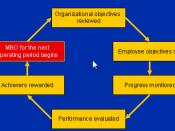Management by Objectives (MBO) was first introduced by Drucker in the 1950's as a system called 'management by objectives and self-control' (Dinesh & Palmer, 1998.) The original basis for the system, as defined by Drucker, was that an organisation would be more successful if "their efforts all pull in the same direction, and their contributions fit together to produce a whole, without gaps, without friction, without necessary duplication of effort..." (Drucker 1955, sited in Dinesh & Palmer, 1998.) The focus was on goal alignment as a way to improve organisational performance, and was thought, at the time to be the best way to increase profitability (D'Aveni, 1995.)
Drucker's ideas were expanded on and implemented in 1960 by McGregor at General Mills and became known as 'management by objectives.' McGregor held that if an employee is directly involved in the goal setting process, they can be relied upon for self-control. Therefore productivity can be best improved by clarifying strategically aligned goals and coupling this with a related rewards system for achievement (Dinesh & Palmer, 1998.)
Hence the concept of MBO (based on goal congruence) was held to be of most benefit at improving employee productivity if undertaken collaboratively.
Since its successful application at General Mills, MBO became increasingly popular during the 1960's and 1970's (Dinesh & Palmer, 1998.) The common elements of an MBO system are; objectives are established for all jobs in the firm; the use of joint objective setting; the linking of objectives to strategy; emphasis on measurement and control; the establishment of a review and recycle system (Reddin & Kehroe, 1974.) Hence MBO plays an integral part of the planning process for an organisation as it seeks to involve all employees in the process with the view that by collaboratively setting goals an increased commitment to attaining them...


